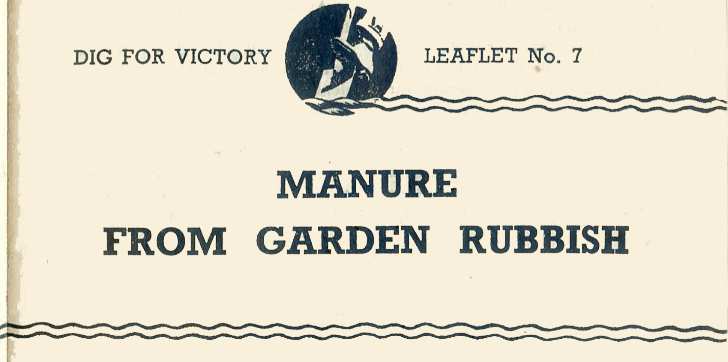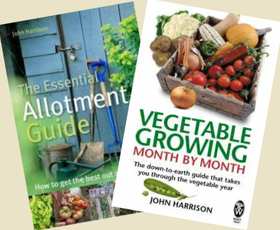
MANURE FROM GARDEN RUBBISH
HOW TO MAKE A COMPOST HEAP
BY means of a compost heap, demanding neither much time nor labour, and little or no expense, all the vegetable waste of the garden can be turned into valuable manure.
Leaves, grass cuttings, sods, lawn mowings, pea or bean or potato haulms, outer leaves or tops of vegetables, hedge clippings, weeds and faded flowers; in short, any plant refuse, green or otherwise, can be used for manurial purposes.
Such a conversion of waste to good use, if widely adopted, can make a considerable contribution to the national effort for increased food production.
The process known as composting is based on the fact that if vegetable matter, soil, water and air are brought together and provided with a “starter,” which may be animal manure or a chemical, a fermentation or digestion takes place. Lime (especially slaked lime or chalk) is necessary to neutralize the acids which are formed. This action converts the materials to humus, a substance essential for maintaining the fertility of all soils.
Kitchen refuse, if it cannot be fed to pigs or livestock, should be well mixed with the other material and added to the heap. N.B. Food waste may not be fed to livestock nowadays by law.
Autumn leaves, on account of their dryness, tend to decompose slowly, and should be mixed with sappy material or even dealt with in a separate heap. Decomposition of very fibrous matter, such as the stems of some herbaceous plants, cabbage stumps or potato haulms, will be hastened if it is chopped into short lengths and broken up.
Autumn leaves are best made into leafmould unless there is only a small quantity.

How to Make a Compost Heap
The heap should be made in the shape shown in the sketch above, 4-7 ft. wide, 3-5 ft. high and of any convenient length according to the amount of material likely to be available. The turf and soil are removed from the site (preferably a spot shaded from the full heat of the sun) to a depth of one foot and retained on one side. Layers of materials are then put in as follows :—
First. A layer of vegetable refuse (the more mixed it is the better) about 4-6 in. thick. Should it be dry and stemmy, moisten it (not more) and trample it well—the more broken it is, the better. If green and sappy, lay it loosely.
Second. A layer of animal manure (from horse, cow, pig or small livestock—best of all, mixed) ½-1 in. thick; or a sprinkling of one of the proprietary chemicals sold for this purpose by most horticultural dealers.
If animal manure has been used, a sprinkling of lime should be given after each 4-6 in. layer of refuse, but it is best not to apply the lime directly on the animal manure. A layer of refuse or soil should be left between the lime and the animal manure.
If one of the proprietary compost makers is used, this will probably contain sufficient lime.
Wood ashes or bonfire ashes may be used in place of lime, and any kind of liquid manure may take the place of animal manure.
Third. A layer of soil ½-1 in. thick. In summer or with dry materials, more should be used ; in winter or with sappy stuff, less is necessary. If the soil is loose in texture, it should be more generously applied than soil of a stiff or sticky nature.
If available, it will be a great help if a little old compost from an earlier heap is mixed with the soil.
These three basic layers should be repeated until the full height is reached, and the whole heap should then be covered with a coating of soil ½-1 in. thick. No other chemicals are needed, but wood or bonfire ashes, and any kind of liquid manure may be added during the building of the heap.
In many gardens, sufficient material will probably not be available to make a complete heap at one operation, and the heap may be built gradually; but after about two weeks in summer, or six weeks in winter, it should be finished off, even if the prescribed height has not been reached, and a new one started.
It is perfectly possible to compost without special bins but few nowadays would add layers of soil and case the heap in soil. Generally the heap is still built in layers consisting of green materials, brown materials and activator such as manure. The addition of a little lime is, I feel, beneficial although some disagree that it is necessary.
Turning the Heap
In a few days according to the material and the weather conditions, the heap should generate heat; or at least become warm. If it does not, no harm is done, but it will be longer before the material is
ready for use.
A heap which has become very hot (hotter in the middle than can be borne by the bare hand) may he turned over after 3-6 weeks, when it has begun to cool down. A cool heap should be left 6-12 weeks
before turning over. Turning over should be done from one end, mixing the layers, and the original outside of the heap should be thrown inside.
After a further period, which may vary from 3 weeks to 6 months, the whole heap should be uniformly dark in colour, with a pleasant earthy smell, and all the material completely rotted. It is then ready for use. A second or third turning will accelerate the completion of the process, hut is not normally necessary.
Weeds
If the composting is proper!, done, perennial roots, such as couch grass, and the seeds of annual weeds will be destroyed by the combination of heat, moisture and active fermentation.
A Valuable Manure
The amount of nitrogen in well-made compost from garden waste may equal that in farmyard manure, and the potash and phosphate contents may be even higher. It is a valuable manure for all crops, and should he buried not more than 3-4 in. deep. Lightly hoed in, it is an excellent mulch or top-dressing.
Materials not to be used
These include cinders, paper (both of which should in any event not be classed us waste), coal ashes, very thick woody stems or cuttings, sawdust, or any material tainted with oil, creosote, tar or any poisonous or preservative chemical.
Paper and plain cardboard can be composted but in the war all paper and cardboard had to be recycled. There were serious penalties if newspapers were found in the bin.
The Garden Bonfire
This should be restricted to the smallest limits and confined to woody material, old pea sticks, diseased material and the thickest underground parts of docks, etc. All other vegetation should find its way back to the soil.
The ashes from a bonfire should not be left out for the rain and dew to wash away the very soluble form of potash contained in them. They should be dug in immediately they are cold, incorporated in the compost heap, or bagged and stored in a dry place.
The bonfire should be started early for it to be out before black-out time.
‘DIG FOR VICTORY’ LEAFLETS
No. 2. ONIONS, LEEKS, SHALLOTS, GARLIC.
,, 3. STORING VEGETABLES FOR WINTER USE.
,, 4. PEAS AND BEANS.
,, 5. CABBAGES AND RELATED CROPS.
,, 9. BORDEAUX AND BURGUNDY MIXTURES.
,, 10. JAM AND JELLY MAKING.
,, 11. BOTTLING AND CANNING.
,, 13. STORING POTATOES FOR FOOD AND SEED.
,, 14. DRYING: SALTING: PICKLES: CHUTNEY.
,, 16. GARDEN PESTS AND HOW TO DEAL WITH THEM.
,, 18. BETTER FRUIT—DISEASE CONTROL, IN PRIVATE GARDENS.
COPIES MAY BE OBTAINED—FREE OF CHARGE—FROM THE ADDRESS
BELOW
Issued by the Ministry of Agriculture and Fisheries, Hotel Lindum—St. Annes – on – Sea—Lancashire.


